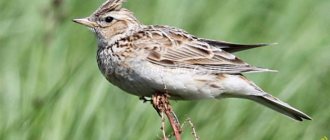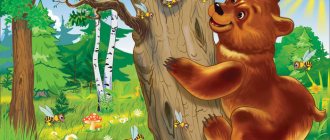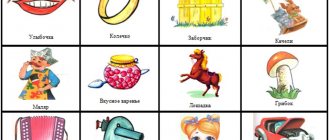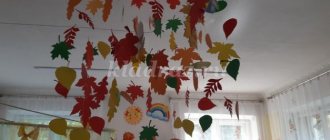Summary of music lessons in kindergarten for middle group children
Summary of a lesson on artistic and aesthetic development (music) for children in the middle group of kindergarten.
Topic: “Journey to a Fairy Tale” This lesson may be of interest to music directors of kindergartens Purpose: To create conditions for the formation of musical abilities of children of primary preschool age Objectives: to improve singing skills; consolidate skills in playing wooden spoons in an ensemble; to form emotional responsiveness to the music listened to; develop a sense of harmony; develop the ability to perform dance movements related to the text; bring pleasure from collective activities; develop speech Repertoire: Song-chant “Hello, palms” by M. Kartushina “Bus” by S. Zheleznova “Let’s make a circle even” by L. Nekrasov “We live together in kindergarten” by V. Kornikova “Sad mood” by A. Steinville “Bear” by V. Rebikov Materials and equipment: piano, music center, toys - bun, hare, bear, wooden spoons according to the number of children, “bus” - assembled chairs
PROGRESS OF THE LESSON
Children enter the music room accompanied by cheerful music Greeting the Muses of the Hands: Hello, guys! Let's greet each other Song-chant “Hello, palms” Music of hands: Guys, please tell me, do you like fairy tales? Answers from the children of the Muses of Hands: Very good! Today I would like to invite you to visit a fairy tale. Well, the way there is not close, how can we get there? Children offer their own versions of the Music of Hands : Guys, I suggest we all go to a fairy tale together on the bus Children take seats on the bus Musical and rhythmic movements “Bus” Children sit on the bus from chairs and ride to the music, performing movements according to the text of the song Music of the Hands : We've had a blast, and now let's go on foot. Hurry up, guys, get off the bus and look at me! On the right is a friend, on the left is a friend. Everyone quickly stand in a circle. Guess who will appear here now? It was baked from flour and sour cream in a hot oven. He lay on the window and ran away from the house. He is ruddy and round. Who is this? (Kolobok) Well done! And here he is! The Musician of Hands shows the children a toy - Kolobok Kolobok (the toy is voiced by the teacher): Hello, children! Music of hands: Hello, Kolobok. How round and rosy you are. Guys, let's join hands and show how round, even and neat Kolobok is. Children stand in a circle, hold hands, “Let’s make a circle even.” Children perform an exercise based on the lyrics of the song The gingerbread man disappears during the exercise The music of the hands: Guys, where is the kolobok? Where did he go? (looks around) He's nowhere to be found! Let's look for it with our eyes. Gymnastics for the eyes I’ll look to the right, to the left, but I won’t find the bun. No below, and no above. Where are you, Kolobok, Ay!. Music of hands: Well, guys, let's not be upset. Let's sit down on the chairs and wait Listening to “Sad Mood” The Hare of the Muses of Hands appears : Children, who came to us? Children give their answers to the Muses of Hands: What is the bunny’s mood? Children: Sad, sad. Music of hands : Hello Bunny! Have you seen Kolobok? Bunny: I haven’t met Kolobok, and without the game I’m bored. Play with me a little, and then you will go on the road. Music of hands: Guys, let’s do some fun exercises together with the bunny. Hurry up and stand in a circle. Physical exercise: “Jump and jump.” Bunny: Thank you guys, you made me laugh. It's time for me to run, I ran. “Bear” sounds again. Music of hands : Children, who else do you think is coming to us? Children: Bear Muses of Hands: How did you guess? A Bear appears with a basket containing noise instruments. Bear: Hello, children. Children greet the Music of Hands : Tell us, Mishenka, have you met a bun on the road? Bear: I definitely haven’t met Kolobok, because I played with musical instruments. I'm the only one, but there are many tools, and I need help! Music of hands: Guys, let's play on our spoons together with the bear Playing music “Orchestra on Spoons” Children play on spoons to the music Bear: How good you are! Everyone played with all their hearts! It's time for me to go home, goodbye, kids. Music of Hands: We danced with the bunny And we played on spoons with the teddy bear Well, you still haven’t found Kolobok? Suddenly a child's cry is heard in the recording of the Music of Hands: Listen, guys, who is that crying in the corner? Children find Kolobok Kolobok: I'm lost! Music of Hands: You shouldn’t have run away from us, it’s good that we found you, otherwise you would have gotten into trouble again! Kolobok : I won’t run away anymore, I’ll obey! Music of Hands: Guys, let's invite Kolobok to our kindergarten? Children answer the Muses of Hands: Stay with us, little bun, in kindergarten. We have a lot of fun and interesting here. And our song “Kindergarten” : Guys, our journey into a fairy tale has ended, it’s time to go back to kindergarten. Hurry up, take your seats on our bus “Bus” Everyone gets on the bus and returns to the kindergarten Music of the Hands: Our fabulous journey has ended. Let's remember where we went today? Children : In a fairy tale. Music of hands: Who did we meet? Children give answers to the Muses of Hands: What did you do with them? The children answer the Muses of Hands: Well, now it’s time for us to say goodbye. Goodbye guys The children say goodbye and go to the group
We recommend watching:
Summary of a musical GCD in the middle group on the topic: New Year Summary of an open music lesson in the middle group of a kindergarten Rhythmic exercises with sticks for children 4-5 years old Musical lesson for children of the middle group in a kindergarten
Similar articles:
Summary of a music lesson for middle group children
Rhythm lesson for middle and senior kindergarten groups
Tasks of musical development in the first junior group
Musical and rhythmic movements
Development of emotional responsiveness to music. Development of musical ear. Formation of basic movements (walking, running, jumping). Introduction to the elements of dance movements. Formation of the ability to correlate movements with music. Development of elementary spatial concepts. Developing a sense of rhythm
Teach children to hear the beginning and end of music. March rhythmically and clap your hands.
Finger games
Perform simple finger games with text with children. Develop coordination of movements of fingers and hands. Learn to correlate movements with the content of nursery rhymes and poems.
Listening to music
Formation of emotional responsiveness to music. Development of ideas about the world around us. Expanding vocabulary.
Sing along
Expanding your horizons and vocabulary. Formation of active singing along. Development of emotional responsiveness to music of various types. Developing the ability to perform movements in accordance with the lyrics of songs.
Dances, games
Formation of activity in games and dances. Development of a sense of rhythm. Formation of basic dance skills. Formation of communication relationships. Development of movement coordination.
| September (8 hours) | |||
| Subject | Forms and types of musical activity | Program tasks | Repertoire |
| "Toys and rattles" | Musical activities Listening to music Perceiving musical works | Teach: - listen to cheerful and calm music; - react emotionally to the content (what or who is being sung about). | “Dogs” (music by M. Mozaffarova, lyrics by A. Erikey) Reader for music classes in kindergarten. “Autumn Song” (lyrics by N. Frenkel, music by A. Alexandrova). |
| Singing Mastering singing skills Singing along | Promote familiarization with singing, singing along with repeated phrases. Learn to recognize familiar songs and understand their content. | “Ak kuyan” (words and music by M. Bikbova) UMK Moral education in children. “Chebek-Chebek” (lyrics and music by F. Batyrshina) Zhyr.biep usebez. | |
| Finger gymnastics | Develop coordination of movements of fingers and hand. | Finger games songs: “Teddy bear”, “In the forest”. | |
| Musical and rhythmic movements: Exercises Dance Games | Teach: - walk briskly and run easily in a flock; - actively stomp your feet to the beat of different types of music; - perform dance movements as shown by adults, start and end movements with music; - distinguish between two-part music. Develop motor activity. | “March” (E. Parlova) “We walk and run” (E. Tilicheeva) “Tatar halyk biyue” (music by M. Mozaffarova). “Hide and Seek with a Bunny” (G. Finarovsky) “Stomp” (music by M. Rauchverger) “Catch up with the kitten” (E. Tilicheeva) “Spring” (Russian Nar.mel) “Warm-up” (words and music by E. Makshantseva) “Shaltyravyklar belen biyu” (Tat. folk melody “Anisa”) Zhyrlap biep uinybyz. | |
| Introduction to children's musical instruments | Familiarity with some musical instruments. | Rattle “Shaltiravyk” (music and lyrics by M. Bikbaeva) | |
| Holidays and entertainment | Arouse interest in the performance. | “The Ryaba Hen” (Russian folk tale) | |
| October (8 hours) | |||
| Subject | Forms and types of musical activity | Program tasks | Repertoire |
| “Autumn has come to visit us” | Musical activities Listening to music Perceiving musical works | Teach: - listen and distinguish between different songs and dances; - respond to music with movements of the arms, legs, clapping, stamping, shaking the head. | “Chebiler” (music by M. Faizullin, lyrics by L. Khairutdinova) U.M.K. Tugan telde soileshebez. “Yangyr” (music by I. Yakupov) Reader for music students in kindergarten “Yokla Kurchak” (music by M. Mozafarov, lyrics by M. Takhirova) UMK Tugan telde solashebez. “Atta” (music by F. Akhmatov) Reader for music lessons. “Ak kuyan” (lyrics and music by M. Bikbov) UMK Moral education in kindergarten.” “Merry Song” (music by A. Filipenko) |
| Singing Mastering singing skills Singing along | Cause emotional responsiveness to songs of a different nature. Encourage people to sing along at the end of phrases. Learn to listen and recognize familiar songs. | “Chebek-chebek” (lyrics and music by F. Batyrshina) Zhyrlap biep uinybyz. “Cockerel” Russian folklore model by M. Krasev. “Rain” (M. Partskhaladze) | |
| Finger gymnastics | Develop coordination of movements of the fingers and hand. Teach children to perform finger games with text. | Musical finger games; "In the Forest", "Autumn". | |
| Musical and rhythmic movements: Exercises Dance Games | Teach: - walking and light running skills; - dance with objects; - move freely to the music throughout the hall; - perform a soft spring. Develop mobility and dexterity skills in dancing and games. Learn gaming activities. | “March” (music by E. Tilicheeva) “Porovoz” (music by A. Filipenko, lyrics by T. Volgina). “Catch up with the cockerel” “Tatar halyk biyue” (music by M. Mozaffarov) UMK Tugan telde soileshebez. “Horse” (music by E. Tilicheeva) “Leaves are spinning” (Russian folk chalk) “Bunnies” (music by T. Lomova) “Kuyankailar ham bure” (music by E. Tilicheeva) “At the bear” (r.n. .m). | |
| Holidays and entertainment | . Stimulate joint musical and gaming activities, develop emotional responsiveness. | "Golden Autumn" Performance by pre-groups | |
| November(8 hours) | |||
| Subject | Forms and types of musical activity | Program tasks | Repertoire |
| “This is how we can do it!” | Musical activities Listening to music Perceiving musical works | Teach: - perceive melodies of a calm, cheerful nature; - distinguish between quiet and loud sounds, high and low sounds. | “Quiet and Loud” by E. Tilicheeva “Cockerel” Russian. adv. Melody “Minem senlem” to the words of R. Valeeva, music of the Tatar people. “Zhyrlap-biep uynybyz.” “Birds” by the muses of G. Fried. “Teddy Bear” by G. Fried. “Rattles” of muses by A. Filipenko. |
| Singing Mastering singing skills Singing along | To encourage adults to join in singing along, accompanying singing with expressive movements. Learn to recognize familiar songs. | “Shaltyravyk” music and lyrics by M. Bikbova “Zhyrlap-beep uinybyz”. “Cockerel” Russian folk song. “Chebiler zaryadkasy” music by L. Khairutdinova, lyrics by G. Lotfi. UMK Tugan telde solashebez. | |
| Finger gymnastics | Develop coordination of movements of the fingers and hand. Teach children to perform finger games with text. | Musical finger games: “Morning”, “Teddy Bear” | |
| Musical and rhythmic movements: Exercises Dance Games | Learn: - actively move to different types of music; - dance in pairs, do not lose your partner, perform dance movements as shown, all together; - figuratively show the movements of animals. Develop activity, the ability to respond to music by changing movements. | “Walking” by the muses of E. Perlov. “Mice and the Cat” musical repertoire. “Polka” by K. Longchamp-Drushkeevichova. “Spring” Russian folk melody. “Sparrows and a car” by T. Lomova’s muses. “We Learned to Walk” lyrics and music by E. Makshantseva. “Blind Man's Bluff with a Tambourine” Russian folk melody. “Boots” Russian folk melody. “We learned to walk” lyrics and music by E. Makshantseva. | |
| Introduction to children's musical instruments | Familiarity with some musical instruments | Tambourine. | |
| Holidays and entertainment | Arouse interest in the musical fairy tale. | Fairy tale: "Turnip" | |
| DECEMBER (8 hours) | |||
| Subject | Forms and types of musical activity | Program tasks | Repertoire |
| "Our Happy New Year!" | Musical activities Listening to music Perceiving musical works | LEARN: — listen to songs and understand their content; - recognize familiar musical works, respond emotionally to their character. | “Chyrshykay” by M.Garaev U.M.K “Tugan telde soyleshabez”. “Sleep, my bear” (E. Tilicheeva-Yu. Ostrovsky) “Quiet and loud” by E. Tilicheeva. |
| Singing Mastering singing skills Singing along | Strengthen the ability to finish singing repeated phrases in a song after adults; - start singing after the introduction with the support of an adult. Learn to sing along without shouting at a moderate pace, calmly. Expand your singing range. | “Chyrshy Yanynda” to lyrics by I. Shamsutdinova, music by S. Uraisky, “Kysh Babai” to lyrics by F. Shaimardanova, music by M. Anderzhanova.” “Zhyrlap biep uinybyz.” “Little Christmas tree” (lyrics by Z. N. Alexandrov, music by M. I. Krasev) “Santa Claus” (music by A. Filipenko, lyrics by A. Volgina) | |
| Finger gymnastics | Develop coordination of movements of fingers and hand. | “Minem tubym” (Balachak uynap kol.user chak) “Bunnies” (Ladushki manger) | |
| Musical and rhythmic movements: Exercises Dance Games | Teach: - convey the cheerful, calm nature of music in movement; - perform movements with objects; - start and end movements with music; - change movements with changing music with the help of adults; - rhythmically clap, stomp, spring. Arouse interest in the musical game, an emotional response to the musical and gaming activity. | “Game with rattles” (M. Rauchwerger) “Mene minem ayuym” (music and lyrics by R. Gatina, F. Batyrshina) “Zhyrlap biep uynybyz.” “At the Bear” (E. Perlova). “Dance of Snowflakes” (T. Lomovoy). “Playing with a fox” muses (N. Frenkel) “Squat” to Y. Entin, Estonian folk muses “I really want to dance” (A. Filipenko-E. Makshantseva) | |
| Holidays and entertainment | Bring joy from participating in a festive event. Learn the rules of behavior in a festive environment. | New Year's celebration | |
| JANUARY (6 hours) | |||
| Subject | Forms and types of musical activity | Program tasks | Repertoire |
| "Zimushka winter" | Musical activities Listening to music Perceiving musical works | LEARN: — listen to songs and understand their content; - identify happy and sad music. Cultivate an emotional response to music of a different nature. Contribute to the accumulation of baggage of your favorite musical works. | “March of the Puppets” (music by R. Enikeev). “Petrushka” (music by A. Filippenko). “Apipa” (Tatar.nar.mel). |
| Singing Mastering singing skills Singing along | Strengthen the ability to sing along with repeated phrases in a song and recognize familiar songs. Teach: - enter with the support of adults; - sing along without shouting at a moderate tempo. Expand your singing range. | “Kaida beznen kullarybyz?” (words and music by F. Shaimardanova) Zhyrlap biep usebez. “Ak kuyan” (lyrics and music by M. Bikbov) “Morals in kindergarten.” “White Snowflakes” (music by G. Gladkov, lyrics by I. Shaferan) | |
| Finger gymnastics | Teach children to perform finger games with text. | “Beznen neni yaklar” (Balachak uyn.kol.user chak) “Zainka” (ladushki manger) | |
| Musical and rhythmic movements: Exercises Dance Games | Teach: - convey the cheerful and calm nature of music in movement; - perform movements with objects; - start and end movements with music. Develop a sense of rhythm, mobility, activity. Develop an interest in musical and active games. | “Mene minem ayuym” (words and music by R. Gatina) Zhyrlap biep yuynyybyz. “Bear” (music by M. Rauchwerger). “Squat” (lyrics by Yu. Entin, Estonian folk music). “Cat and Mice” (music by E. Tilicheeva). “Anisa” (Tatar folk melody). “Catch the Bunny” (Tat.n.dance). “Hide and seek with a cockerel” (Tat.n.dance). “Look for the fox and the cockerel” (Estonian folk music). | |
| Holidays and entertainment | It brings joy from meeting with cheerful, playful music and active play. | Winter fun | |
| FEBRUARY (8 hours) | |||
| Subject | Forms and types of musical activity | Program tasks | Repertoire |
| "I and my family" | Musical activities Listening to music Perceiving musical works | LEARN: — listen to songs and understand their content; - determine the cheerful and calm nature of the music. Cultivate an emotional response to music of a different nature. Contribute to the accumulation of baggage of your favorite musical works. | “On a horse” (music by F. Akhmatov). “Sleep, Tanyusha, bye-bye-bye” (Russian n.p.) “March” (music by V. Deshevov). |
| Singing Mastering singing skills Singing along | LEARN: - enter with the support of adults; - sing without shouting at a moderate tempo. Strengthen the ability to sing along to repeated phrases; recognize familiar songs. Expand your singing range. | “Kaida beznen kullarybyz?” (words and music by F. Shaimardanova) Zhyrlap biep usebez. “Rekhmet eniem!” (lyrics by A. Minkhazhev, music by A. Khadieva) UMK Tugan telde soileshebez. “Mommy” (music by E. Tilicheeva). | |
| Finger gymnastics | Develop coordination of movements of the fingers and hand. Teach children to perform finger games with text. | “Min ele bik kechkene” (Balachak uyn.kol.user chak) “Handles clap clap” (Ladushki manger) | |
| Musically rhythmic movements: Exercises Dance Games | Teach: - convey the cheerful and calm nature of music in movement; - start and end movements with music. - stay in pairs, moving around the entire hall; - change movements with the help of adults; - easily and rhythmically stomp, spin, gently perform a spring; - figuratively show the movements of animals. Develop a sense of rhythm and coordination of movements. | “Gopachok” (ukr.nar.mel) Exercise with flags” (music by T. Vilkoreiskaya) “Porovoz” (music by A. Filipenko, lyrics by T. Volgina). “Horse” (music by M. Rauchwerger). “The Bear and the Bunny” (G. Finarovsky). | |
| Holidays and entertainment | It brings joy from meeting with cheerful, playful music and active play. | "We are friendly guys" | |
| MARCH (8 hours) | |||
| Subject | Forms and types of musical activity | Program tasks | Repertoire |
| « Spring" | Musical activities Listening to music Perceiving musical works | Teach: - listen not only to contrasting works, but also to plays of a visual nature; - recognize the sounds of rain in music; - tap rhythmically with your finger; - recognize familiar pieces of music. Contribute to the accumulation of musical impressions. | “Chipchyklar tavyshy” UMK Tugan telde soyleshabez. “Sun” (T. Popatenko). “March of the Puppets” (music by R. Enikeev). |
| Singing Mastering singing skills Singing along | Form the skills of basic singing intonations. Learn not only to sing along, but also to sing simple songs with short phrases in a natural voice, without shouting, start singing along with adults. | “Syerchyk” (music by I. Shamustdinov, lyrics by G. Lotfi) Reader for music lessons. “Maemai” (lyrics by M. Jalil, music by F. Yarullin) UMK Tugan telde soileshebez. “Rekhmet eniem!” (lyrics by A. Minkhazhev, music by A. Khadieva) UMK Tugan telde soileshebez. “Mommy” (music by E. Tilicheeva). | |
| Finger gymnastics | Teach children to perform finger games with text. | “It’s cool for a bunny to stand” (Ladushki manger) “Without atlap barabyz” (Balachak uyn.kol. user chak) | |
| Musical and rhythmic movements: Exercises Dance Games | Teach: - walk cheerfully while marching, easily run in one direction in a flock; - jump easily on two legs; - skills in mastering simple dance movements; - change dance movements with changing music - move freely around the hall. Develop the ability to convey character images in games (cat, kittens) | “March” (music by T. Lomova). “Balls” (T. Lomovoy) “Dance with handkerchiefs” (E. Tilicheeva) “Cat and kittens” (V. Vitlina) “Sparrows and a car” (music by T. Lomovoy). “Balls” (T. Lomovoy). “We quarreled and made up” (mu T. Vilikoreyskaya). | |
| Introduction to children's musical instruments | Introducing some musical instruments (continued) | “Tambourine” by G. Frida (Playing with a tambourine by the muses of M. Krasev, lyrics by N. Frenkel) | |
| Holidays and entertainment | Develop aesthetic feelings. | Musical fairy tale "Teremok". | |
| APRIL (8 hours) | |||
| Subject | Forms and types of musical activity | Program tasks | Repertoire |
| "Spring" | Musical activities Listening to music Perceiving musical works | Teach: - listen not only to contrasting works, but also to plays of a visual nature; - recognize familiar pieces of music; - distinguish between low and high sounds. Contribute to the accumulation of musical impressions. | In the forest: “Tukran tavyshy” (Moral education in kindergarten). “Kuyannar” (music by F. Shaimardanova, Tatar folk words) Zhyrlap-beep uinybyz. “Sun” (T. Popatenko). |
| Singing Mastering singing skills Singing along | Form the skills of basic singing intonations. Learn not only to sing along, but also to sing simple songs with short phrases; sing in a natural voice, without shouting; start singing with adults. | “Sun” (lyrics by A. Barto, music by M. Rauchwerger). “Etech” (lyrics by M. Jalil, music by J. Fayzi) UMK Tugan telde solashebez. “Drip-drip” (muses and muses F. Filkenshtein). | |
| Finger gymnastics | Teaches how to correlate movements with the content of drills and poems. | “Poplyashi” (Ladushki manger) “Mene minem un kulym” (Balachak uyn.kol.user chak) | |
| Musical and rhythmic movements: Exercises Dance Games | Teach: - walk quietly and squat to rest; - perform movements with objects; - distinguish contrasting music; - change dance movements with changing music; - move freely around the hall. Continue working on mastering simple dance movements. Develop the ability to convey character images in games. | “Playing with a bear” (b.n.m. ed. E. Tilicheeva) “Catch up with the bunny” (E. Tilicheeva) “Bright ribbons” (music by A. Aleksandorova S. I. Ivinets). “Big and small legs” (music by V. Agafonnikov) “Bear” (music by M. Rauchwerger). “We quarreled and made up” (mu T. Vilikoreyskaya). | |
| Holidays and entertainment | D evelopment: aesthetic feelings. Educate: interest in puppet shows; sympathy for the heroes. | Puppet show “Ziyushkina’s hut” | |
| MAY (8 hours) Date added: 2018-02-28; views: 2021; We will help you write your work! ⇐ Previous7
… … © 2014-2021 — Studopedia.Net — Student information resource. All materials presented on the site are solely for the purpose of information for readers and do not pursue commercial purposes or copyright infringement (0.006) |




